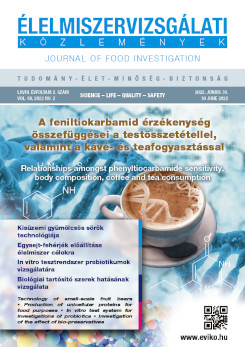Effect of a compound bio-preservative on microbiological indicators and shelf life of fresh pork chops
Main Article Content
Abstract
The article deals with the study of the effect that a compound preservative produces on microbiological indicators and shelf life of fresh pork products. The effect of various preservatives on the total viable count and yeast growth in fresh meat during storage was studied. Experimental studies have shown that the compounds of additive a preservative mixture* actively inhibits microorganism growth during the fresh pork chops storage. In the control sample, the number of microorganisms on the seventh day of storage was 12*104 CFU/g, and, in the sample with the compound additive preservative mixture added, it amounted to 0.1*104 CFU/g. The usage of the ready to use preservative mixture allows actively suppressing the yeast reproduction during long-term storage (seven days) of coarsely chopped fresh pork products (250 CFU/g). The optimal method for applying the preservative to fresh pork chops has been determined. Applying the preservative to coarsely chopped fresh meat by simply mixing and massaging (for example, together with spices or marinades) is the most rational method for this product type. Primary and secondary lipid degradation products are considered, and the peroxide and acid numbers of fresh meat products during 30-day storage are determined. After 30 days of storage, a noticeable increase in oxidative processes in the control sample is observed, whereby the end point of the shelf life of coarsely chopped fresh pork products has been chosen.
Downloads
Article Details
References
Saucier, L. (2016): Microbial spoilage, quality and safety within the context of meat sustainability. Meat Science, 120, pp. 78–84. https://doi.org/10.1016/j.meatsci.2016.04.027[2] Huffman, R. D. (2002): Current and future technologies for the decontamination of carcasses and fresh meat. Meat Science, 62, pp. 285–294. https://doi.org/10.1016/s0309-1740(02)00120-1[3] Zhang, H. Z., Wu, J., Guo, X. (2015): Effects of antimicrobial and antioxidant activities of spice ex-tracts on raw chicken meat quality. Food Science and Human Wellness, 5, pp. 39-48. https://doi.org/10.1016/j.fshw.2015.11.003[4] Chen, J. H., Ren, Y., Seow, J., Liu, T., Bang, W. S., Yuk, H. G. (2012): Intervention Technologies for Ensuring Microbiological Safety of Meat: Current and Future Trends. Comprehensive Reviews in Food Science and Food Safety, 11,pp.119–132.[5] Naveena, B. M., Sen, A. R., Vaithiyanathan, S., Babji, Y., Kondaiah, N. (2008): Comparative efficacy of pomegranate juice, pomegranate rind powder extract and BHT as antioxidants in cooked chicken patties. Meat Science, 80, pp. 1304–1308, https://doi.org/10.1016/j.meatsci.2008.06.005[6] Aymerich, T., Picouet, P. A., Monfort, J. M. (2008): Meat decontamination technologies for meat products. Meat Science, 78, pp. 114–129. https://doi.org/10.1016/j.meatsci.2007.07.007[7] Lucera, A., Costa, C., Conte, A., Del Nobile, M. A. (2012): Food applications of natural antimicrobial compounds. Frontiers in Microbiology, 3, pp. 1–13. https://doi.org/10.3389/fmicb.2012.00287[8] Russell, S. M. (2009): Understanding poultry spoilage. Available at: http://www.wattagnet.com/articles/4207-understanding-poultry-products-spoilage. Last accessed 14th April 2017.[9] Doulgeraki, A. I., Ercolini, D., Villani, F., Nychas, G. E. (2012): Spoilage microbiota associated to the storage of raw meat in different conditions. The International Journal of Food Microbiology, 157, pp. 130–141. https://doi.org/10.1016/j.ijfoodmicro.2012.05.020[10] Soladoye, O. P., Juárez, M. L., Aalhus, J. L., Shand, P., Estévez, M. (2015): Protein oxidation in pro-cessed meat: mechanisms and potential implications on human health. Comprehensive Reviews in Food Science and Food Safety, 14, pp. 106–122. https://doi.org/10.1111/1541-4337.12127[11] Thomas, C. J., O’Rourke, R. D., McMeekin, T. A. (1987): Bacterial penetration of chicken breast muscle. Food Microbiology, 4(1), pp. 87–95. https://doi.org/10.1016/0740-0020(87)90022-0[12] Scallan, E., Hoekstra, R. M., Angulo, F. J., Tauxe, R. V., Widdowson, M. A., Roy, S. L., Jones, J. L., Griffin, P. M. (2011): Foodborne illness acquired in the United States-major pathogens. Emerging Infectious Diseases, 17,pp.7–15. https://doi.org/10.3201/eid1701.P11101[13] Waites, W. M. (1998): The microbiology of meat and poultry. Meat Science, 50(1), p. 137. https://doi.org/10.1016/s0309-1740(98)00009-6.[14] Antipova, L. V., Glotova, I. A., Rogov, I. A. (2001): Meat and meat products research methods, Mos-cow, Kolos, pp. 376.[15] Skurikhin, I. M., Tutelyan, V. A. (1998): Guide to methods for analysis of food quality and safety. Moscow, Brandes, Medicine, pp. 342.[16] Viljoen, B. C., Geornaras, A., Lamprecht, A., Holy, A. (1998): Yeast populations associated with pro-cessed poultry. Food Microbiology, 15, pp. 113-117. https://doi.org/10.1006/fmic.1997.0137[17] Aminzare, M., Hashemi, M., Ansarian, E., Bimkar, M., Azar, H. H., Mehrasbi, M. R., Daneshamooz, S., Raeisi, M., Jannat, B., Afshari, A. (2019): Using Natural Antioxidants in Meat and Meat Products as Preservatives: A Review. Journal of Animal and Veterinary Advances, 7, pp. 417–426.

